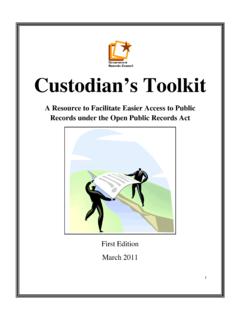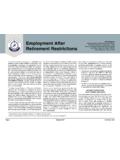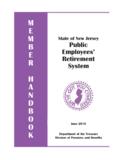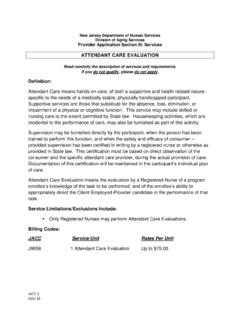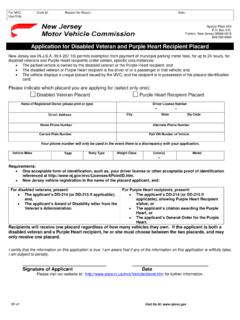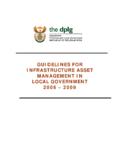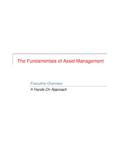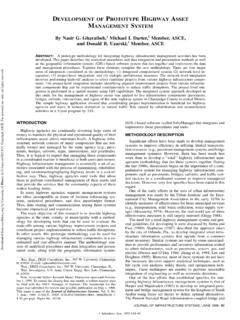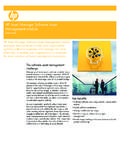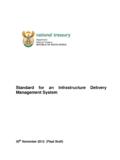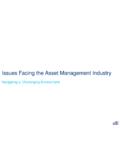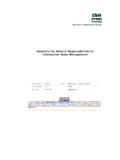Transcription of Asset Management Guidance and Best Practices
1 The standards and best Practices contained in this document are required elements for new projects seeking State funding under the New Jersey Environmental Infrastructure Finance Program (NJEIFP). Further information on the NJEIFP can be found at the following link(s): and Asset Management Guidance and best Practices Managing Utility Assets in New Jersey Introduction The NJDEP is responsible for evaluating, managing and protecting New Jersey's water resources to ensure that a safe, adequate, and reliable water supply is available to the public and to restore, enhance, and maintain the chemical, physical, and biological integrity of the waters of the State. To ensure drinking water and wastewater systems are adequately maintained and operated to continually and reliably meet customer service expectations as well as comply with applicable permit conditions, NJDEP rules generally require drinking water and wastewater utilities to demonstrate that they have adequate facilities, and equipment, and that they regularly perform operation and maintenance to meet the conditions in their This includes conducting an inventory of system assets, providing adequate staffing and training, performing preventative maintenance, and demonstrating adequate funding.
2 In order to meet these requirements, a utility must identify its needs and costs, and develop long-range financial plans. The current best Management practice for ensuring such financial planning is through the development and implementation of an Asset Management Plan. Asset Management planning consists of developing a plan to reduce costs while increasing the efficiency and the reliability of the assets. An Asset Management plan incorporates detailed Asset inventories, operation and maintenance tasks and long-range financial planning to ensure that annual revenue reserves and reinvestment are sufficient to facilitate long-term viability of the system. The five major, generally recognized components of a utility Asset Management plan include: Performing an inventory and condition assessment of the system's assets.
3 Defining level of service goals;. Identifying critical assets;. Establishing life cycle costs, and Developing a long-term funding strategy. Purpose AP Photo/Mel Evans Many systems currently practice Asset Management to varying degrees. To ensure that all utilities operate their facilities so that they achieve compliance with the rules and/or terms and conditions of their permits, the Department has developed this technical Guidance that summarizes the elements of an Asset Management strategy that will meet applicable regulatory requirements and promote more responsible investment and rehabilitation of New Jersey's drinking water and wastewater system infrastructure. The phrase Asset Management is a widely accepted industry practice through which capital assets are inventoried, monitored, and managed over time to ensure the longevity and sustained viability of the assets as components of an effectively functioning system.
4 While NJDEP rules do not use the phrase Asset Management plan , the rules do require that systems monitor, plan, and maintain facility assets to ensure the reliable operation of the utility. DEP is currently promulgating new rules to incorporate the term Asset Management plan . Systems are encouraged to use this information in concert with the variety of related material that can be accessed through the links provided under Resources below as they begin or enhance their on- going Asset Management efforts in conformance with the rules. Implementing Asset Management for New Jersey's Wastewater and Drinking Water Utilities To facilitate meaningful, cost-effective water and wastewater system rehabilitation and maintenance and to support appropriate Asset Management endeavors, the Department is rededicating its efforts to ensure that permittees fulfill their long-standing Asset Management requirements.
5 This strategy will be implemented in stages to allow sufficient flexibility for all systems while providing the Department an opportunity to assist its regulated partners. 1. As part of and to initiate the first phase of its comprehensive Asset Management strategy, the NJDEP expects to offer financial assistance to offset the costs of developing an Asset Management plan. A. Through the USEPA's designated Sandy appropriation, the financing package for this effort is expected to consist of the following: $15 million for Asset Management planning assistance ($5 million under the Hurricane Sandy Drinking Water SRF and $10 million under the Sandy Clean Water SRF). Individual assistance packages will include a principal forgiveness loan for 30% of allowable costs, an interest-free loan for 45% of the costs, and an NJEIT market-rate loan for 25%.
6 In accordance with USEPA requirements, activities for which Sandy-related SRF monies are provided must result in direct capital projects. B. In addition, the 2014 Clean Water and Drinking Water SRF Intended Use Plans continue to provide bonus points for sponsors that have an Asset Management plan and projects that are identified in an Asset Management plan. The additional points serve to prioritize those entities with an established Asset Management plan in place over other project sponsors that have yet to develop a plan. At a minimum, the expected deliverable must contain an inventory of system components ( source, treatment, distribution/conveyance, storage, pump stations, hydrants, manhole covers, discharges/outfalls, etc.) including the mapped location (see mapping requirements under Asset Inventory/Condition Assessment section below), a description of age, criticality and remaining useful life.
7 More specific Asset Management requirements may be outlined in permit conditions, developed policy Guidance , or in future rulemaking, as appropriate. What is Asset Management ? Asset Management is the Management of the physical components of a drinking water or wastewater system and can include: pipe, valves, tanks, pumps, wells, hydrants, treatment facilities, and any other components that make up the system. While Asset Management planning can also include human resources necessary for the proper operation of the facility, this guide focuses on the hard assets' or infrastructure only. The assets that make up a water or wastewater utility generally have a fixed life cycle and lose value over time as the system ages and deteriorates. Along with this deterioration, the ability of the utility to reliably deliver the level of service that the utility's customers expect may be compromised.
8 As physical system assets age and deteriorate, the costs of operation and maintenance increase a classic example of pay me now or pay considerably more later . Similarly, if sufficient revenues are not reserved and the system's assets are not adequately maintained, the utility may be faced with excessive costs that it cannot afford when system components falter or fail altogether. Proper Asset Management allows a system to plan responsibly and make more informed decisions about proactively managing aging assets on a continual basis to ensure the long-term sustainability of the entire system. Why Manage Assets? According to the USEPA, successful Asset Management enables a drinking water or wastewater system to maintain a desired level of service in the most cost-effective manner.
9 Generally, this allows utility managers to proactively rehabilitate or replace system components on a continual basis rather than waiting to repair failing or damaged assets when it is considerably more expensive and disruptive to system operations. Asset Management is important for several reasons: Utility assets represent a major public or private investment;. Increased knowledge of the system allows better financial decisions, and can influence choices when considering options to address various system challenges ( meeting regulatory requirements or upgrading system security). Enables efficient and cost-effective operation of the system;. Reliable infrastructure promotes economic development; and Efficient system operation and maintenance is essential to public health and safety and protection of water quality.
10 May provide greater access to financial assistance. Some funding sources give applicants extra credit (higher priority ratings) for having an Asset Management plan or a capital improvement plan. Benefits of Asset Management Systems that fully embrace Asset Management principles may achieve many benefits. The benefits of Asset Management include, but are not limited to: Ensuring the long-term sustainability of the utility. Identifying Asset location, condition, and criticality Prolonged Asset life through sound decision-making and focused operations and Management Promote system reliability, resilience and sustainability Consistently meeting customer demands Setting realistic rates based on sound operational and financial planning Budgeting focused on activities critical to sustained performance Meeting service expectations and regulatory requirements Reducing occurrences of and improving response to emergencies Reduced energy needs and costs Improving system security and safety of assets Public Outreach Explaining the importance of Asset Management to the decision makers and the public is essential because the benefits of a successful Asset Management plan are realized over time and may not be readily apparent ( the number and severity of emergencies minimized/avoided).
